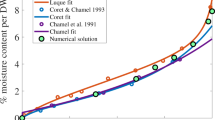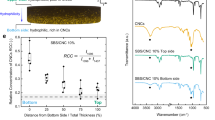Summary
Using isolated cuticular membranes from ten woody and herbaceous plant species, permeance and diffusion coefficients for water were measured, and partition coefficients were calculated. The cuticular membranes of fruit had much higher permeance and diffusion coefficients than leaf cuticular membranes from either trees or herbs. Both diffusion and partition coefficients increased with increasing membrane thickness. Thin cuticles, therefore, tend to be better and more efficient water barriers than thick cuticles. We compared the diffusion coefficients and the water content of cuticles as calculated from transport measurements with those obtained from water vapor sorption. There is good to fair agreement for cuticular membranes with a low water content, but large discrepancies appear for polymer matrix membranes with high permeance. This is probably due to the fact that diffusion coefficients obtained from transport measurements on membranes with high permeance and water content are underestimated. Water permeabilities of polyethylene and polypropylene membranes are similar to those of leaf cuticular membranes. However, leaf cuticles have much lower diffusion coefficients and a much greater water content than these synthetic polymers. This suggests that cuticles are primarily mobility barriers as far as water transport is concerned.
Similar content being viewed by others
Reference
Crank J (1975) The mathematics of diffusion. Oxford University Press, Oxford
Barrer RM (1968) Diffusion and permeation in heterogeneous media. In: Crank J, Park GS (eds) Diffusion in polymers. Academic, London, pp 259–313
Felder RM, Spence RD, Ferrell JK (1975) A method for the dynamic measurement of diffusivities of gases in polymers. J Appl Polymer Sci 19: 3193–3200
Hartley GS, Graham-Bryce IJ (1980) Physical principals of pesticide behaviour, vols I and 2. Academic, New York London
Holloway PJ (1982) The chemical constitution of plant cuticles. In: Cutler DF, Alvin DL, Price CE (eds) The plant cuticle. Academic, London, pp 45–85
Kamp H (1930) Untersuchungen über Kutikularbau und kutikuläre Transpiration von Blättern. Jahrb Wiss Bot 72: 403–465
Keidel FA (1959) Determination of water by direct amperometric measurement. Anal Chem 31: 2043–2048
Riederer M, Schönherr J (1984) Accumulation and transport of (2, 4-Dichlorophenoxy) acetic acid in plant cuticles. I. Sorption in the cuticular membrane and its components. Ecotoxicol Environ Safety 8: 236–247
Riederer M, Schönherr J (1985) Accumulation and transport of (2, 4-dichlorophenoxy) acetic acid in plant cuticles. II. Permeability of the cuticular membrane. Ecotoxicol Environ Safety 9: 196–208
Rust G, Herrero F (1969) Untersuchung der Wasserdampfpermeation durch Folien. Materialpruefung 11: 166–169
Schatzberg P (1965) Diffusion of water through hydrocarbon liquids. J Polym Sci 10: 87–92
Schönherr J (1976a) Water permeability of isolated cuticular membranes: the effect of pH and cations on diffusion, hydrodynamic permeability and size of polar pores in the cutin matrix. Planta 128: 113–126
Schönherr J (1976b) Water permeability of isolated cuticular membranes: the effect of cuticular waxes on diffusion of water. Planta 131: 159–164
Schönherr J (1982) Resistance of plant surfaces to water loss: transport properties of cutin, suberin and associated lipids. In: Lange OL, Nobel PS, Osmond CB, Ziegler H (eds) Encyclopedia of plant physiology, vol 12 B, Physiological plant ecology II. Springer, Berlin Heidelberg New York, pp 154–179
Schönherr J, Lendzian K (1981) A simple and inexpensive method of measuring water permeability of isolated plant cuticular membranes. Z Pflanzenphysiol 102: 321–327
Schönherr J, Mérida T (1981) Water permeability of plant cuticular membranes: the effects of humidity and temperature on permeability of non-isolated cuticles of onion bulb scales. Plant Cell Environ 4: 349–354
Schönherr J, Riederer M (1986) Plant cuticles sorb lipophilic compounds during enzymatic isolation. Plant Cell Environ 9: 459–466
Schönherr J, Schmidt HW (1979) Water permeability of plant cuticles. Dependence of permeability coefficients of cuticular transpiration on vapor pressure saturation deficit. Planta 144: 391–400
Schönherr J, Eckl K, Gruler H (1979) Water permeability of plant cuticles: the effect of temperature on diffusion of water. Planta 147: 21–26
Yasuda H, Stannett V (1962) Permeation, solution and diffusion of water in some high polymers. J Polymer Sci 57: 907–923
Author information
Authors and Affiliations
Rights and permissions
About this article
Cite this article
Becker, M., Kerstiens, G. & Schönherr, J. Water permeability of plant cuticles: permeance, diffusion and partition coefficients. Trees 1, 54–60 (1986). https://doi.org/10.1007/BF00197025
Issue Date:
DOI: https://doi.org/10.1007/BF00197025




